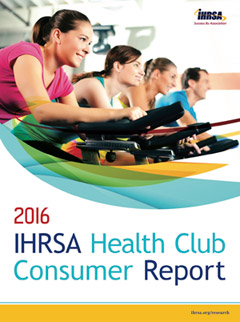IHRSA Releases 2016 Health Club Consumer Report: U.S. Health Club Membership Reached High of 55.3 Million in 2015
Posted: September 7, 2016 in IHRSA
 2016 Health Club Consumer Report
2016 Health Club Consumer Report
BOSTON, MA – The International Health, Racquet & Sportsclub Association (IHRSA) released the 2016 Health Club Consumer Report. This annual publication, based on a nationwide sample of more than 32,000 interviews, provides demographics and health, sports and fitness participation data on American health club consumers.
“Membership in US health clubs reached an all-time high of 55.3 million in 2015, representing an annual growth rate of 3.3% over the past three years,” said Jay Ablondi, IHRSA’s executive vice president of global products. “Another 9.1 million non-members exercised at clubs in 2015, bringing the total number of Americans utilizing health clubs to 64.4 million, also a record high.”
Health club usage and activity preferences vary widely across generational groups, a finding which club operators can consider in strategic positioning and program development. Generation X is more likely to utilize resistance machines and treadmills, while Millennials are more likely to participate in yoga and cross-training programs. Boomers are more inclined to engage in Tai Chi and aquatic exercise.
“As the Consumer Report bears out, distinctions in activity participation impact club preferences among consumers,” said Melissa Rodriguez, IHRSA’s senior research manager. “While Millennials opt for studios to engage in specific training formats, Generation X’ers are more likely to use fitness-only and multipurpose clubs for access to various training equipment.”
Through several club applications, the report guides club operators in leveraging such demographic trends in efforts to stand out from the competition. Owners of full-service health clubs may consider cultivating an offer that emphasizes group training and building a strong online presence in order to engage Millennials. Club operators who aim to target Boomers may not only offer relevant exercise programs, but also provide stellar in-person customer service and foster ongoing interactions with club staff.
The 2016 IHRSA Health Club Consumer Report is organized into the following chapters:
- Chapter 1. U.S. Health Club Membership Trends: analysis of total membership growth trends and growth rates by segment;
- Chapter 2. Member Demographics and Implications for the Industry: an exploration of gender, household income, age, and educational demographics as well as how national demographics are influencing the health club industry;
- Chapter 3. Member Behavior: Preferences, Attendance & Participation: insights on membership tenure, attendance, and activity participation across demographics;
- Chapter 4. Health & Fitness Club Membership Fees: Price Elasticity: an exploration of consumer pricing points across facility segments and in relation to economic indicators;
- (NEW) Chapter 5. Personal Training & Small Group Training in the Health Club Industry: an analysis of training users and spending;
- Chapter 6. Overarching Insights & Takeaways from Health Club Consumer Research: a summary of opportunities for health club owners, operators and staff;
- Chapter 7. How to Apply Consumer Findings: five in-depth applications for club operators and implications for suppliers;
- (NEW) Appendix – Infographic Insights: infographics on key consumer data points, including personal and small group training users and members by club pricing model.
The 2016 IHRSA Health Club Consumer Report is based on analysis of 32,658 online interviews that were carried out with a nationwide sample of individuals and households in late 2015. This publication is available in PDF format at ihrsa.org/consumer-report for $99.95 (IHRSA member price) and $199.95 (non-members).

